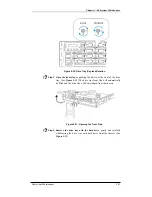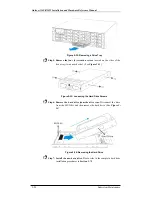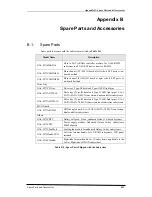
Galaxy A16F-R2422 Installation and Hardware Reference Manual
Subsystem Maintenance
5-18
5.7 Cooling Module Maintenance
5.7.1 Cooling Module Overview
•
Redundant cooling modules:
The A16F-R2422 is equipped with two
(2) redundant, hot swappable, dual-blower cooling modules located on
the lower level of the subsystem rear panel. These cooling modules
control the internal operational temperature of the subsystem and
therefore their working integrity should be maintained at all times.
•
Detecting a failed cooling module:
If a cooling module fails, the LED
located at the back of the module, an audible alarm, the firmware, the
RAIDWatch panel view, or the Configuration Client can notify you.
•
Replacing a cooling module:
Once you are notified that a cooling
module has failed, it should be replaced as soon as possible. A failed
cooling module should only be removed from the subsystem when you
have a replacement module immediately available that can be installed
as soon as the failed cooling module has been removed.
WARNING!
The latches at the back of the cooling module secure the cooling module
into the enclosure. If these latches are broken, the warranty on the
cooling module will be void.
5.7.2 Replacing a Cooling Module
If one of the cooling modules fails, it must be replaced as soon as possible.
The cooling modules are secured to the chassis with the two (2) black
latches located on the rear surface of the module itself. To replace the
cooling module, please follow these steps:
WARNING!
•
Although the cooling modules are fully redundant, it is not
advisable to run the
A16F-R2422
with a single cooling module for
an extended period of time. If the remaining cooling module fails,
the system is at risk of sustaining irreparable damage.
•
Keep a failed module in its enclosure bay until a replacement unit is
in hand.
Step 1.
To remove the cooling module,
pull both side latches toward the
center of the cooling module. Withdraw the cooling module from
the subsystem by gently pulling on the silver handle at the bottom of
the module. (See
Figure 5-27
)
















































